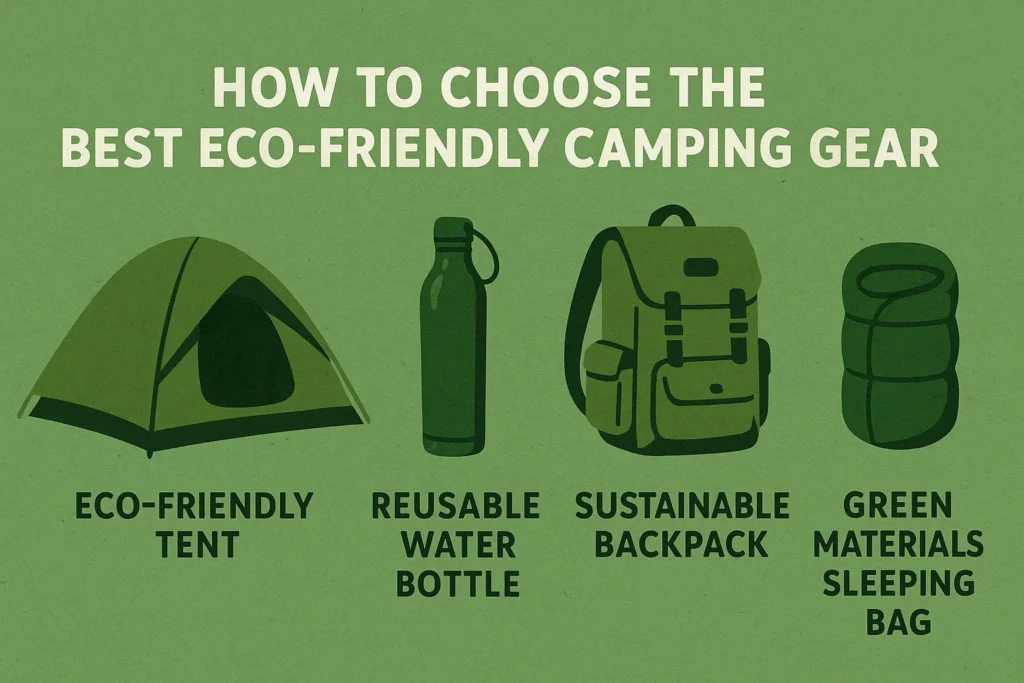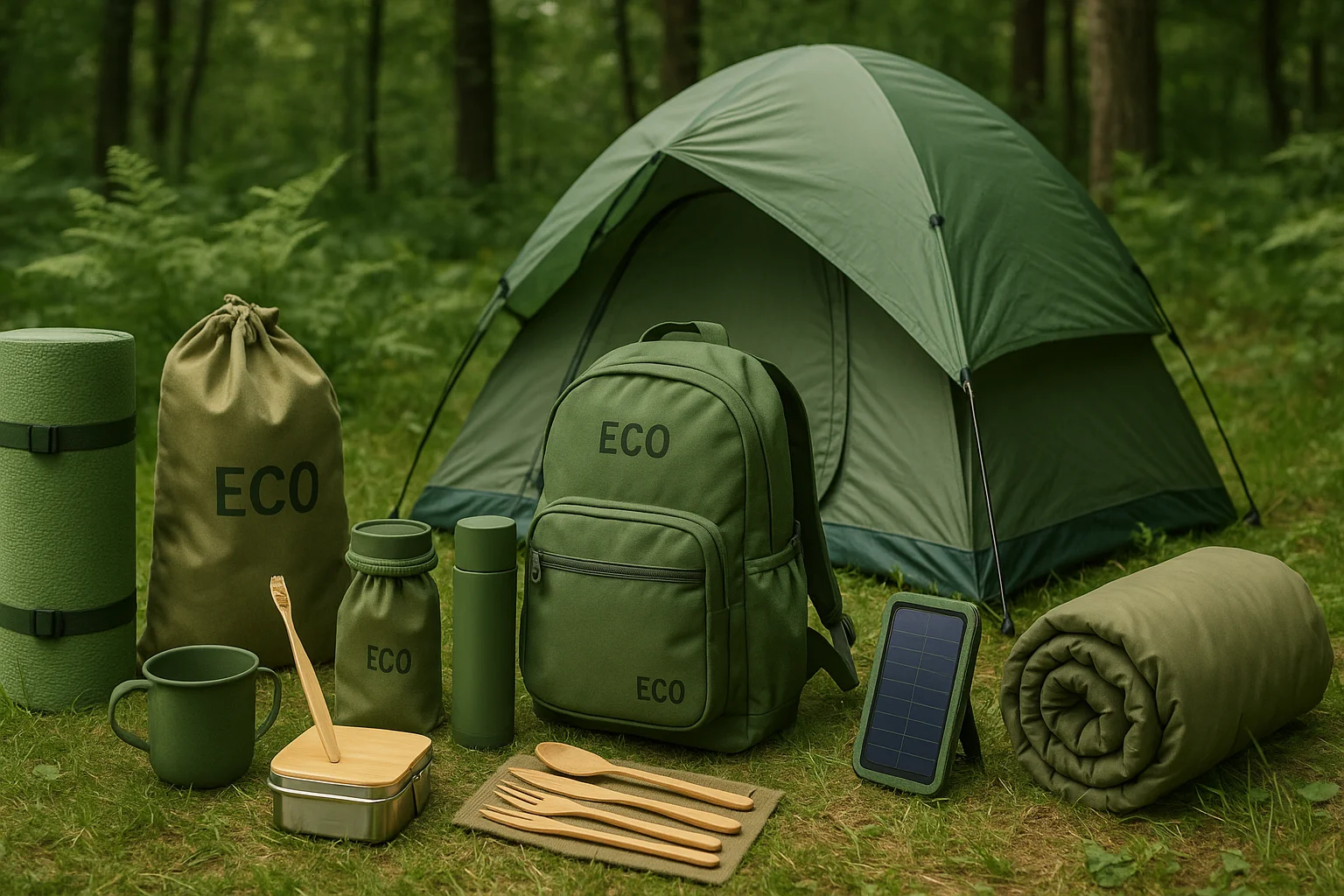Camping allows us to escape the chaos of city life and reconnect with nature. However, traditional camping gear often contains plastics, harmful chemicals, or single-use items that harm the very environment we seek to enjoy. That’s where eco-friendly camping gear steps in. Choosing sustainable gear not only reduces your carbon footprint but also ensures a safer and more ethical outdoor adventure.
In this guide, we’ll explore must-have eco-friendly camping essentials, provide real-life examples, and share how Eco Gear Guides can help you make better choices for sustainable outdoor living.
Why Choose Eco-Friendly Camping Gear?

Many nature lovers are shifting towards sustainable camping for three main reasons:
- Environmental Impact – Reduces plastic waste, pollution, and carbon emissions.
- Durability & Quality – Eco-friendly gear often lasts longer, saving money in the long run.
- Health & Safety – Non-toxic, BPA-free, and chemical-free products make camping safer for families and pets.
Example: Instead of using disposable plastic utensils, bamboo cutlery sets can be reused for years while biodegrading naturally at the end of their life cycle.
Essential Eco-Friendly Camping Gear for Nature Lovers
1. Sustainable Tents and Shelters
Look for tents made from recycled polyester, organic cotton, or durable hemp canvas. Some brands even use solar-powered manufacturing.
- Example: LifeStraw Peak Series filters thousands of liters of water, giving hikers safe hydration while cutting down on single-use plastic bottles.
2. Reusable Cooking Gear
Replace single-use plastics with stainless steel, titanium, or bamboo options.
- Eco Swap: Reusable stainless-steel cups vs. disposable plastic cups.
- Eco Gear Guides recommends collapsible silicone cookware that saves space and reduces waste.
3. Solar-Powered Gadgets
Camping often requires lighting, charging, and cooking tools. Solar-powered lanterns, chargers, and stoves reduce dependency on batteries.
- Real Example: A solar camping lantern can provide 12 hours of light on a single day’s charge—no batteries needed.
4. Biodegradable Toiletries
Regular soaps and shampoos release harmful chemicals into rivers and soil. Opt for biodegradable versions that decompose naturally.
- Tip: Always use them at least 200 feet away from natural water sources.
5. Eco-Friendly Sleeping Bags & Mats
Choose organic cotton sleeping bags or mats made from recycled foam. They are lightweight, durable, and sustainable.
Comparison Table: Traditional vs. Eco-Friendly Camping Gear
| Camping Item | Traditional Option | Eco-Friendly Alternative | Benefit for Nature |
|---|---|---|---|
| Utensils | Disposable Plastic | Bamboo or Stainless Steel | Biodegradable, reusable |
| Lighting | Battery Lanterns | Solar-Powered Lanterns | Renewable energy use |
| Sleeping Bag | Synthetic Fiber | Organic Cotton / Recycled Fill | Reduced carbon footprint |
| Toiletries | Regular Soap/Shampoo | Biodegradable Toiletries | No water pollution |
| Tent | Nylon with Chemicals | Recycled Polyester / Hemp | Low-impact materials |
Real-Life Example: A Green Camping Trip in Yosemite
Last summer, a group of campers in Yosemite National Park decided to go completely green. Instead of carrying bottled water, they used two LifeStraws for drinking directly from streams. They cooked meals with stainless steel mess kits and powered their lanterns with solar chargers.
At the end of their 5-day trip, they produced only one small bag of waste compared to the multiple bags most campers generate. This practical example shows how eco-friendly camping gear reduces environmental impact without compromising convenience.
Read More : Top Eco-Friendly Fabrics You Should Know
How to Choose the Best Eco-Friendly Camping Gear
When shopping for sustainable outdoor gear, keep these points in mind:

- Check Materials: Look for recycled, organic, or biodegradable options.
- Durability Over Cheapness: Invest in gear that lasts longer.
- Energy Efficiency: Opt for solar-powered or rechargeable gadgets.
- Ethical Brands: Support companies that prioritize sustainability.
Eco Gear Guides curates lists of verified eco-friendly products, making it easier for campers to find gear that aligns with their values.
Benefits of Eco-Friendly Camping
- Protects Nature: Reduces pollution and waste.
- Healthier Choices: Avoids toxins and chemicals.
- Long-Term Savings: Durable products reduce replacement costs.
- Positive Influence: Inspires fellow campers to adopt sustainable habits.
Conclusion
Eco-friendly camping gear is not just a trend—it’s a responsibility. By choosing sustainable tents, solar-powered gadgets, and biodegradable toiletries, nature lovers can camp with minimal impact on the environment.
With the help of Eco Gear Guides, you can discover reliable products and tips that make green camping both practical and enjoyable. The next time you head outdoors, pack gear that respects the environment—because protecting nature ensures we can keep enjoying it for generations to come.
Read More : Top Zero-Waste Travel Essentials
FAQs About Eco-Friendly Camping Gear
Q1: Is eco-friendly camping gear more expensive?
Not always. While some items may cost more upfront, their durability often makes them more affordable in the long run.
Q2: Can solar-powered gear work in cloudy conditions?
Yes, most solar gear stores energy and can function even with limited sunlight.
Q3: Where can I find eco-friendly camping gear in Pakistan/abroad?
You can explore trusted online stores, or check recommendations from Eco Gear Guides for sustainable options.
Q4: How can beginners start eco-friendly camping?
Start small—swap disposable items for reusable ones, invest in biodegradable toiletries, and gradually add more sustainable gear to your kit.
Q5: Do biodegradable soaps really make a difference?
Yes. They break down naturally, preventing water pollution and protecting aquatic life.


